CURRICULUM
ArT
Art Curriculum Intent
Art is a vital part of children’s education; It provides them with a visual language through which they can share and express their individual creativity and explore the many ways in which artists from different times and cultures respond to the world around them.
Our Curriculum will equip students with the practical skills in drawing, painting, printmaking, photography, sculpture and mixed media but will also provoke curiosity, expect ambition, develop studentship and provide challenge and support for all our learners.
The Art Curriculum at Horizon
Click here to see where Art can take you
Key STRANDS
Identify formal elements in visual images.
Observation skills
Research and investigation
Students are taught how to draw but not merely with pencil. The wider principles of ‘drawing’ can be applied to coloured media, photography, print-making and sculpture. In their time with us they will experience a wide range of artistic processes and techniques ultimately choosing their own ways of working from the growing repertoire of practical skills.
the use of different tools, materials and techniques
Developing a personal response
Year 7
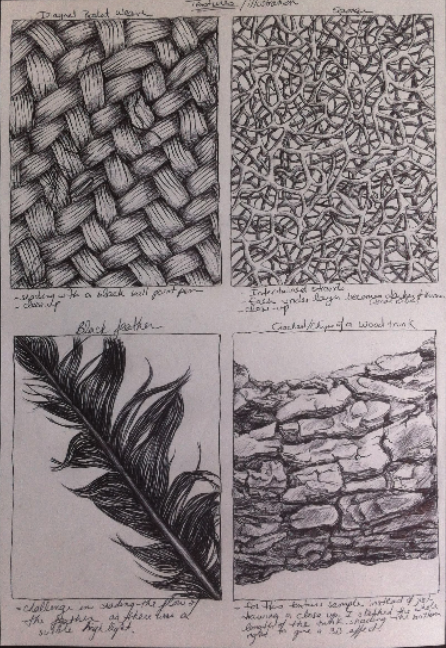
Natural Form
Students will begin their art journey by exploring the basic principles of mark-making, drawing with line and then tone. They will learn how to build a drawing in stages, beginning with simplified shapes then adding line, texture and tone. They will use a variety of natural forms to work from such as shells, fruit and landscape and learn how to observe their subject matter closely and thoughtfully. They will discover the work and techniques of Van Gogh , Karl Blossfeldt and Ernst Haeckel. They will select from their work to create a compositional idea which they will develop. They will make creative choices about the composition and presentation of their final outcome. Home -learning tasks are used to extend and consolidate their knowledge, skills and understanding outside the classroom.
Skills -
Use the ‘LOOK – THINK – DRAW’ technique to draw accurately.
Use a variety of pencil grips and pressures to create a range of marks and tones.
Scaffold a drawing by simplifying the shapes / identifying symmetry.
Experiment with mark-making to create textural effects- create a ‘Dictionary of Marks’
Build a drawing up in several stages :
-quick sketch
- accurate line
-adding tone and texture
Select the most appropriate drawing material for their chosen task (pen/ charcoal/ grades of pencil)
Research an artist and present their work carefully and creatively.
Use a framework to analyse and evaluate artists’ work
Select from their prior work and plan a final outcome.
Experiment with Frottage.


Food, Glorious Food
In this term’s unit of study, students will explore Colour Theory through the topic of food. They will build upon the skills learnt in project 1 through drawing and using line, tone and texture through colour. They will investigate the work of artists Joel Penkman, Wayne Thiebaud and Sarah Graham creating a pastiche and researching their favourite piece of work. They will learn how to mix and manipulate colours to create tints, tones , shades and hues using colouring pencils and paint.
They will create a photoshoot of food and use the resulting photographs to select ideas for a final piece which will be developed using their new skills in colour mixing and application of paint and coloured pencil.
Skills -
Understand colour theory through the colour wheel.
Identify Primary , Secondary and Tertiary Colours
Mix Secondary and Tertiary colours from Primary Colours.
Mix tints , tones and shades from a hue by adding quantities of black and white.
Apply paint with varied brushstrokes to replicate an observed texture.
Use thin paint ( wash) to underpaint, adding thicker paint to add solidity to work as it develops.
Use a framework to analyse and evaluate artists’ work
Understand and apply the term Photorealism and Pastiche
Layer coloured pencil to adapt observed colour.
Create a photoshoot and take photographs of food at home.
Select from their photographs to create a final outcome and realise this through paint and coloured pencil.


'In a junk shop': Observational Drawing
In this unit of work, the art rooms will be transformed with large still life set ups of familiar and unfamiliar objects. Students will learn about the genre of Still life in art and how different artists have responded to this. They will then have the opportunity to consolidate the skills they have learnt in year 7, working from the still life set ups using direct observation drawing skills. They will progress through sketching to making more accurate drawings incorporating the formal elements of tone, line, composition, form and texture. They will develop their work through exploring collage and mixed media to enlarge a section of their drawing and produce a more abstract still-life response.
Skills -
Develop their observational skills and analysis of positive and negative space. Build a drawing up in stages: Simplifying shapes, adding scaffold lines and then developing accurate outlines before creating form and depth with tone. Analyse the ideas and techniques of artists within other still -life art. Use oracy skills to describe , explain and evaluate their own and others work. Develop a non representational colour palette Develop a composition through selection of element and use of mixed media.

Year 8
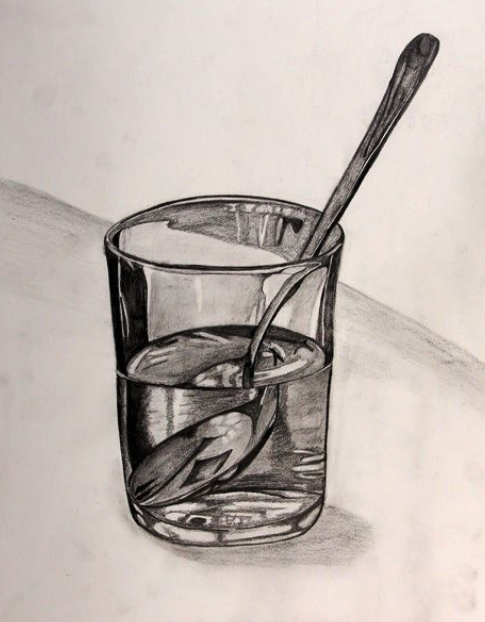
Still -Life
This unit builds upon prior learning in Y7 , developing drawing and observation skills through challenging our students to draw more complex forms and record subtle tonal effects. They will discern the different qualities of shape and form and begin to add a greater range of value to their tonal drawing. They will practice drawing ellipses , then cylinders and eventually a glass, half full of water with a metal spoon in it, They will understand the conventions of still -life art , focussing on the work of Georgio Morandi.
Skills -
Understand the differences between Shape and form.
Learn How to draw ellipses.
Understand proportion and scaffold a drawing using construction lines and symmetry.
Learn about the technique of Chiaroscuro and apply this to their ongoing work
Draw glass, water and metallic object.
Understand the principles of refraction and reflection. Identify range of tones on cylinder and cast shadow.
Demonstrate knowledge about an artist and conduct personal research.
Use a greater range of tonal value to add impact to their drawing.

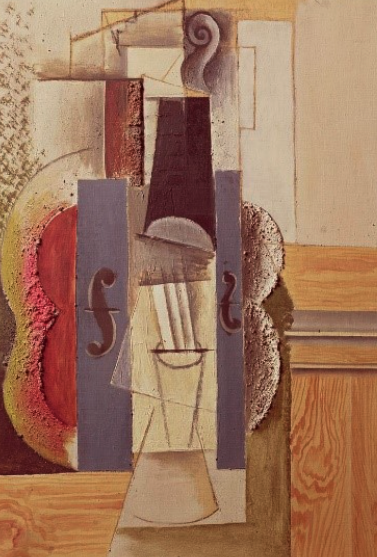
Cubism
This unit builds upon the observational drawing skills in the last term and now challenges students to experiment with the ideas and principles of Cubism. They will learn about the origins of this Art movement and its reactionary context in history. They will understand different viewpoints and deconstruct then re-construct their drawings to create fragmentation and repetition of line and shape. Through experimentation with compositional principles (zoom, rotate, crop, overlap etc) they will develop the cubist effects within their own work. They will select from a variety of materials to develop their best piece of work.
Skills
Understand and experiment with the effects of different viewpoints: Bird’s eye, street level, worm’s eye
Experiment with overlapping, rotating , cropping , zooming in
Understand and experiment with positive and negative space
Select and combine a variety of media and rendering techniques to develop final outcome.
Research and analyse works of Cubist art
Compare and contrast the work of Picasso and Braque

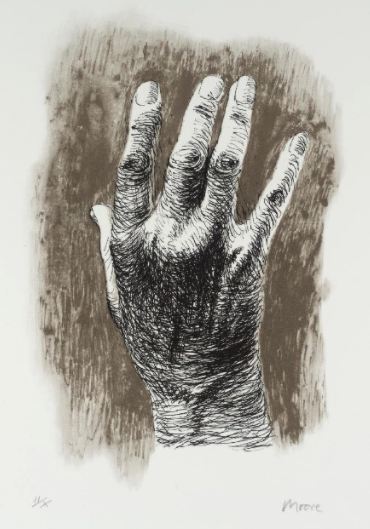
Hands and Surrealism
This term students will learn how to draw one of the most complex subject matters: the human hand. This unit will build upon all their prior learning in using line, tone, form and texture and support them with their visual perception and skills in observational drawing. They will earn about contoured shading and connect their growing understanding with the work of Henry Moore. In the second half of this term they will learn about the Surrealist art movement and apply some of the Surrealists’ conventions to their hand to create a surreal outcome and juxtaposing unexpected objects, backgrounds and surface treatments. They will select from a range of materials and techniques to develop their final outcome
Skills
Develop observation skills working from their own hands and be taught how to observe carefully and purposefully
Scaffold their drawings by using feint lines to simplify shapes and proportions
Apply their skills in tonal rendering to transform a shape into a form. Understand that shapes are flat and forms are fat.
Explore the hand drawings of Henry Moore and develop similar techniques of mark- making
Identify contours within their hand and use contoured rendering to develop what they see.
Develop a drawing from a sketch to a polished and refined final outcome.
Learn about the Surrealist art movement and its context in history, conducting personal research about a suggested artist.
Apply Surrealist conventions to their own work using the ideas of juxtaposition and the combination of unlikely or surprise elements within their final design.
Develop their final outcome using a range of materials and techniques they deem to be most appropriate for their chosen ideas.

Year 9

Portraits
This term students will learn about the genre of Portraiture and be taught how to draw a portrait. They will also explore connected contextual ideas such as a portrait in absentia, altered portraits and the sensitive pen work of Mark Powell. This project will challenge our learners to evidence their growing skill and understanding in using line, tone , proportion, and observation skills but also provide them with an array of exciting ways to develop their resulting portrait and to experiment purposefully and successfully.
Skills
Understand and apply knowledge of facial proportions to develop accuracy in their drawing.
Use scaffolding based on proportion guidelines and symmetry to build a portrait drawing
Make a portrait in absentia through photographing a collection of personal items.
Experiment with altering a portrait through deconstructing, collaging, and working into it with other materials
Explore the work of Mark Powell through a pastiche using biro and mark-making
Develop a portrait study of their own based on themselves or a family member, choosing the style, materials and techniques from prior work and taking photographs to work from

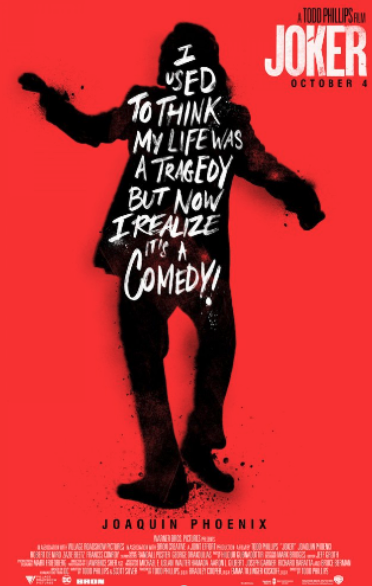
Messages
The final project of year 9 is a GCSE unit of work from a past paper; ‘Messages’. Our students are now in a position where they have more creative independence and a range of practical skills and knowledge enabling them to personalise their ideas and outcomes. They will study a range of artists who use art to express a message or idea. They will develop their own personal ideas through the selection of appropriate images, materials and techniques and apply typography to their work to create a unique and personal message through their art.
Skills
Analyse and evaluate a range of Message art and artists such as Banksy, Cindy Sherman, Faith Ringold
Learn about the development of the poster and how this reflected changes in society eg: Propaganda
Learn about the conventions of typography and the anatomy of written and printed type.
Identify and use Serif, san serif, script and display fonts.
Experiment with a range of ideas and select their strongest design and most impactful lettering style.
Apply colour, tone, line and other formal elements to develop their chosen design

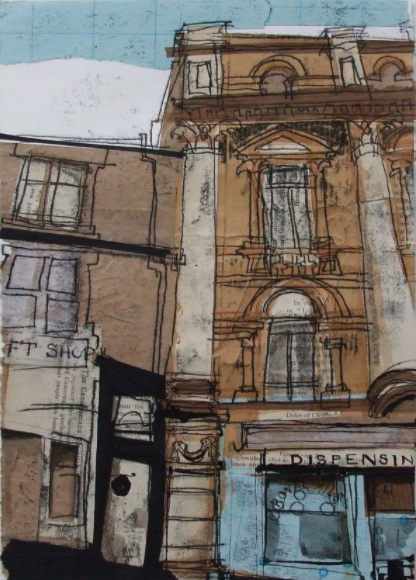
The Built Environment
This term students will focus on learning about perspective and the way we show depth in a visual image. They will learn how to utilise a vanishing point and draw a street view using 1 point perspective and then develop this skill into 2 point perspective. The project develops these new skills through focussing on the work of artists that have used the built environment for inspiration: Seth Clarke, George Politiz and Ian Murphy and experiment with some of these artists’ techniques and materials.
As their knowledge and skills develop, they will be tasked with taking photographs of buildings in their local environment and using these to put together a final outcome, experimenting with compositional tools ( Zoom , crop, rotate, overlap, viewpoint etc)
Skills -
Understand, identify and apply a vanishing point to pictorial landscape / streetscape. Draw with 1 point perspective successfully
Draw with 2 point perspective successfully
Research artists concerned with the built environment and express a preference based on knowledge of their materials and techniques
Experiment with the techniques of Ian Murphy and Seth Clarke
Take photographs in the locality that connect with the work and ideas they have used in the project.
Develop a range of thumbnail sketches from their research, exploring compositional devices ( zoom , crop, rotate , overlap etc as well as perspective )
Select their best idea and develop with the techniques and materials they have found to be most effective.

Year 10
Macro Nature
The first unit of coursework in year 10 is based around Botanical Forms and is an exam theme from a past paper. This theme offers a vast array of possibilities, subject matter and artist references to enable our students to find a personal direction as their coursework develops and to explore a wide range of media, techniques and ideas. The first half of the term will introduce the 3 assessment objectives for GCSE AQA Fine Art:
AO1: Investigating and developing ideas, understanding the artistic context of this theme.
AO2: Experimenting with materials and techniques and refining ideas as they develop
A03: The quality of their recording of their changing ideas as they develop towards a final outcome.
In the second half of the term , students will begin to refine and select from their research and develop a final outcome
AO4: Present a personal and meaningful response that realises intentions.
It is essential that our students continue their learning outside the classroom and will be expected to do this each week for home learning where tasks will be set by their class teacher. An extra curricular club exist s to support this and equipment can be loaned where necessary
Skills -
Skills covered are from the AQA assessment matrix, but we aim to teach in a broader style rather than simply ticking boxes as students won't achieve their best progress if their knowledge and understanding are overly compartmentalised.
The assessment objectives and key skills are below but these skills are co -dependent and interwoven throughout each project.
A01: Develop ideas through investigations demonstrating critical understanding of sources.
A02: Refine work by exploring ideas, selecting and experimenting with appropriate media , materials , techniques and processes
A03 : Record ideas, observations and insights relevant to intentions as work progresses
A04 : Present a personal and meaningful response that realises intentions and demonstrates understanding of visual language
Change & Decay
The second coursework unit of year 10 is again from a past paper. The theme of ‘Change and Decay’ offers much scope for investigation and has a wide range of responses and avenues of exploration; from the textural and visual qualities of rusty metal to the changing environment and the human condition with all its changes.
Students will follow a carefully planned series of lessons designed to allow them creative freedom whilst supporting them to meet the requirements of each assessment objective. They will work towards a final outcome in the second half of the term.
Skills
Skills covered are from the AQA assessment matrix but we aim to teach in a broader style rather than simply ticking boxes as students won't achieve their best progress if their knowledge and understanding are overly compartmentalised.
The assessment objectives and key skills are below but these skills are co -dependent and interwoven throughout each project.
A01: Develop ideas through investigations demonstrating critical understanding of sources
A02: Refine work by exploring ideas, selecting, and experimenting with appropriate media , materials , techniques and processes
A03 : Record ideas, observations and insights relevant to intentions as work progresses
A04 : Present a personal and meaningful response that realises intentions and demonstrates understanding of visual language
Year 11
Mock Exam
This will commence after the summer holiday at the start of year 11. They will use the previous summer’s exam paper and choose their preferred starting point in discussion with their class teacher and based upon their preferred subject matter and techniques / materials. This is their major coursework project but will be titled ‘mock exam’ as their final outcome will be undertaken in exam conditions over 10 hours before Christmas in year 11
Skills
Skills covered are from the AQA assessment matrix but we aim to teach in a broader style rather than simply ticking boxes as students wont achieve their best progress if their knowledge and understanding are overly compartmentalised.
The assessment objectives and key skills are below but these skills are co -dependent and interwoven throughout each project.
A01: Develop ideas through investigations demonstrating critical understanding of sources
A02: Refine work by exploring ideas, selecting and experimenting with appropriate media , materials , techniques and processes
A03 : Record ideas, observations and insights relevant to intentions as work progresses
A04 : Present a personal and meaningful response that realises intentions and demonstrates understanding of visual language
Terminal Exam AQA Exam paper January of Y11 through until Easter
External question papers will arrive 1st January of year 11 and will consist of 7 possible starting points or themes. By this stage students will have a clear picture of their preferred subject matter and favoured techniques and materials and be able to make a considered choice of starting points based on this.
Skills -
Skills covered are from the AQA assessment matrix but we aim to teach in a broader style rather than simply ticking boxes as students wont achieve their best progress if their knowledge and understanding are overly compartmentalised.
The assessment objectives and key skills are below but these skills are co -dependent and interwoven throughout each project.
A01: Develop ideas through investigations demonstrating critical understanding of sources
A02: Refine work by exploring ideas, selecting and experimenting with appropriate media , materials , techniques and processes
A03 : Record ideas, observations and insights relevant to intentions as work progresses
A04 : Present a personal and meaningful response that realises intentions and demonstrates understanding of visual language
